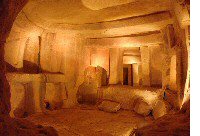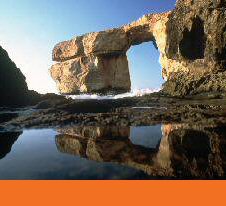

The Maltese Islands
 Located in the Mediterranean Sea, just south of Sicily, the Maltese archipelago basically consists of three islands: Malta, Gozo and Comino. Total population of the Maltese Islands: 413,609
Located in the Mediterranean Sea, just south of Sicily, the Maltese archipelago basically consists of three islands: Malta, Gozo and Comino. Total population of the Maltese Islands: 413,609
The largest island of the group is Malta, from which the archipelago takes its name. Valletta, the capital, is the cultural, administrative and commercial centre of the archipelago. Malta is well served with harbours, chief of which is the Valletta Grand Harbour. Malta's international airport is situated five kilometres from the capital.
The second largest island, Gozo is topographically quite different from Malta. Quaintly attractive for its less industrialised way of life, Gozo can be reached from Malta by ferry-boat from Cirkewwa and Pieta, near Valletta, and by helicopter from the airport.
 Comino, Cominotto, Filfla and St Paul's Islet are the other major features of the archipelago. Of these, only Comino, straddled between Malta and Gozo, sustains a very tiny population. Turned into a popular resort because of a couple of very fine beaches, Comino can be reached from Cirkewwa, either by boat or by excursion ferries during the summer months.
Comino, Cominotto, Filfla and St Paul's Islet are the other major features of the archipelago. Of these, only Comino, straddled between Malta and Gozo, sustains a very tiny population. Turned into a popular resort because of a couple of very fine beaches, Comino can be reached from Cirkewwa, either by boat or by excursion ferries during the summer months.
Position: The distance between Malta and the nearest point in Sicily is 93 km. The distance from the nearest point on the North African mainland (Tunisia) is 288 km. Gibraltar is 1,826 km to the west and Alexandria is 1,510 km to the east.
 This strategic position has allowed Malta to develop as an important trading post. Malta has gone a long way from being a strategic landmark on the military maps of long-gone empires to a strategic location in today's globalised business community. When it obtained its independence from Britian in 1964 Malta had to wake up and transform its economy based on military spending by foreign powers in Malta to a peace-time economy. Manufacturing and tourism where the first industries to emerge, but today the Maltese Islands are levering more on their strategic presence in the centre of the Mediterranean with the concept of being a hub in such sectors are tourism, financial services, transport and telecommunications. New horizons are being sought with Malta joining the European Union. Regardless, liberalisation and innovation are the goal of Malta's economy while making the best out of the splendid human resources which the country counts on to prosper.
This strategic position has allowed Malta to develop as an important trading post. Malta has gone a long way from being a strategic landmark on the military maps of long-gone empires to a strategic location in today's globalised business community. When it obtained its independence from Britian in 1964 Malta had to wake up and transform its economy based on military spending by foreign powers in Malta to a peace-time economy. Manufacturing and tourism where the first industries to emerge, but today the Maltese Islands are levering more on their strategic presence in the centre of the Mediterranean with the concept of being a hub in such sectors are tourism, financial services, transport and telecommunications. New horizons are being sought with Malta joining the European Union. Regardless, liberalisation and innovation are the goal of Malta's economy while making the best out of the splendid human resources which the country counts on to prosper.
The Maltese Islands fall within the following co-ordinates
Northern Latitude 36°00'00"
Eastern Longitude 14°36'00".
Area of the Maltese Islands: 316 km²
 Physical Features: Malta has no mountains or rivers. A series of low hills with terraced fields on the slopes characterise the Island.
Physical Features: Malta has no mountains or rivers. A series of low hills with terraced fields on the slopes characterise the Island.
The coastline of Malta is well indented, thus providing numerous harbours, bays, creeks, sandy beaches and rocky coves. The length of the shoreline round Malta is 136 km, and 43km round Gozo.
Climate: It is the climate, more than anything else, that has made Malta an important tourist resort in the centre of the Mediterranean. The average winter temperature is 12°C (54°:F.) There are really only two seasons in Malta: the dry summer season, and the mild winter season. The average rainfall is 558.2 mm (22 ins). Rain rarely, if ever, falls during the summer months.
Source: doi.gov.mt







